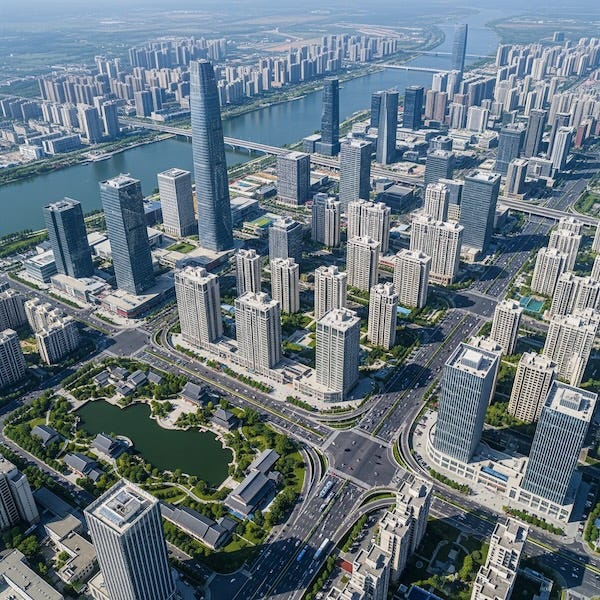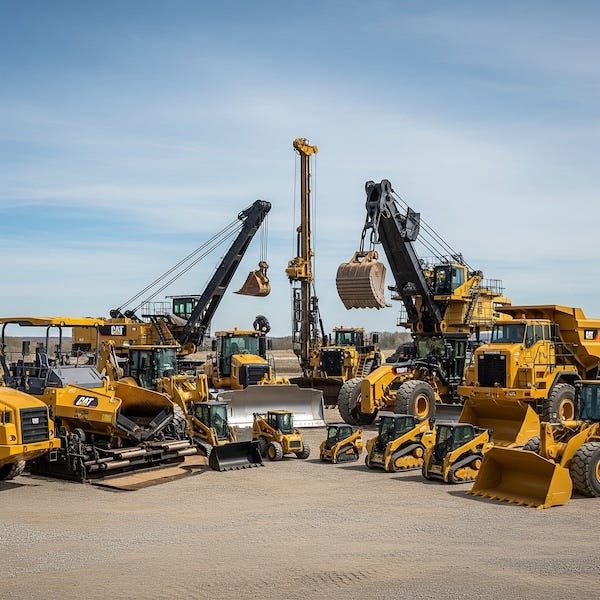“We’re still short Caterpillar.”
Jim Chanos, the famous founder of Kynikos Associates — an investment management firm — said this in 2016.
He had first come out in 2013 with this opinion; that the Caterpillar stock would crash. And he would profit from his short position on the stock.
He didn’t just stop at saying that.
Jim went on to explain why he said what he said.
The main reason: China.
But to understand this, we will need to understand the background – the times, the country, the company, and the bet.
China
China has been building aggressively for a few decades now.
In fact, its multi-decade high growth story meant that China was building everything very fast.
This included highways, roads, railways, bridges, entire cities, dams, power plants, and other such massive infrastructure.
Coupled with this, China was aggressively expanding its manufacturing prowess – which meant more raw materials were needed.
Iron, sand, rare earth metals, coal, and much more.
In China, government officials are routinely transferred and hold offices for short durations.
For them to perform well, they need to appear effective and fast. This means, many of them build homes, roads, and entire cities rapidly.
These cities are based on expectations that people would eventually move in.
Many times, it is well known that the cities will not get occupied. But by the time that question comes up, the government official will have been transferred. The official can show the sheer amount of homes built and get praises.
Then, an empty city will become a problem for the next government official to deal with.
Many local governments are under pressure to show tax revenues. One way to do that is by selling land rights to builders for building such cities.
To aggravate the problem, many large rural areas get remarked as cities or city-states.
That location will be counted as a city. On paper, the residents living there will be urban residents, not rural residents.
What does this mean?
Every year, about 15 million people are ‘expected’ to move from rural to urban areas. Even if a rural area gets recategorised as urban, the population there is counted as a part of the rural-to-urban migrating population.
Every year, the number of people expected to move to urban areas looks much bigger than reality.
Planners and builders build more homes based on this number.
What you end up with is many more homes than buyers.
The last straw in this?
The Chinese love investing in real estate.
Driven by new cities being built, and rural-to-urban migration numbers, more Chinese turned to real estate.
Long story short, there are way more homeowners and lesser buyers. Many of these homes are owned by people who already own homes. So they were looking to only invest, not stay in the properties.
If it was just that, it would have been fine. But it was not.
These homes were not bought using cash. They were bought using loans.
Sounds familiar?
Housing Loan Crisis
The 2008 recession was a housing loan crisis that blew up.
In 1989, one of the biggest bubbles had burst in Japan. That too was a real estate bubble.
Jim Chanos spoke about this ratio: the ratio of the value of the real estate in the country to the GDP.
He used this to show how over-valued the real estate in the country was.
In the case of the Japanese real estate bubble, the ratio was 375% right before the crash. In the this case of the recession of 2008, this ratio was 180% (in the USA). In Ireland’s case, it was 350%.
Jim Chanos estimated that this ratio was greater than 400% for China.
It was a bubble waiting to burst, according to him.
Caterpillar
So what does any of this have to do with Caterpillar?
Caterpillar is also known as just Cat. They make heavy equipment.
Uniquely, Cat’s equipment is vital in anything to do with infrastructure and mining.
They make cranes, bulldozers, loaders, material handlers, dump trucks, digging vehicles — you name it.
In its aggressive push to develop fast, China was using Cat construction equipment heavily.
Cat does not make its revenue share from China publicly available. Either Jim Chanos knew the numbers or estimated it to be pretty high.
Jim’s belief was that since the housing debt was building up, prices were shooting up, and there weren’t enough buyers, there would be a hard recession.
Economies are extremely linked. If one major sector or industry is affected, it is almost never in isolation. The effect spills over to other industries and sectors.
Real estate was a massive part of the Chinese economy. If it fell, it would greatly affect the Chinese economy and eventually, jolt the global economy.
Since this was going to happen sooner or later — according to Jim Chanos — he felt Caterpillar was an excellent company to short.
He started shorting the company in 2013.
In 2014, he reaffirmed his stance: short Caterpillar.
In 2016, he still had not been proven right. But he still believed he was onto something.
Aftermath
The crash did happen, sort of. But much later.
Starting in the 2020s, the Chinese real estate market started showing great stress.
Companies like Evergrande started defaulting, which concerned the Chinese government. They sprung into action trying to control the debt crisis. Their aim was clearly a soft landing.
They made it clear that the houses were not for speculation or investment, but for residing in.
There was a marked slowdown in construction activity.
But by the time this happened, Jim Chanos was no longer shorting the Caterpillar stock. He was done with it. He had waited too long and nothing had happened in that period.
And to add another layer to this story, Jim Chanos was right about the construction bubble. But he was still wrong about Caterpillar.
The company’s stock did not crash.
The company had very diversified sources of revenue from across the world. The Chinese real estate bubble did not dent them as much as Jim Chanos would have thought.
The Caterpillar stock is at an all-time high in 2025. It has been rising pretty consistently since the 2010s.
So Jim Chanos’ short would still not have made him money.
This is a great lesson in just how complex the stock markets can be.
It wasn’t that he was wrong about the Chinese real estate market. He was wrong about the timing — it took much longer for it to happen.
He was also wrong in his assumption that the Caterpillar stock was the correct way to make money out of the Chinese real estate bubble.
Quick Takes
+ The revised version of the Income Tax Bill was introduced today. It replaces the old 1961 Income Tax law with a simpler version. The new Income Tax Bill incorporates most of the recommendations made by the Select Committee.
+ Equity mutual funds saw a record high net inflow of Rs 42,702 crore in July (compared to Rs 23,587 crore in June). Debt funds saw a net inflow of Rs 1.07 lakh crore in July (compared to a net outflow of Rs 1,711 crore in June): AMFI.
+ The US’s inflation rate stood at 2.7% year-on-year in July (same as June). Core inflation rose to 3.1% (vs 2.9% in June).
+ India’s retail inflation rate fell to 1.55% year-on-year in July (vs 2.1% in June). Food inflation fell to -1.76% (vs -1.01% in June).
+ The government approved 4 semiconductor manufacturing units worth Rs 4,600 crore to be set up in Odisha, Punjab, and Andhra Pradesh.
+ The government approved the construction of a 700 MW hydro electric project worth Rs 8,146.21 crore. The project will be set in Shi Yomi district of Arunachal Pradesh.
+ The US national debt crossed $37 trillion, a new record, according to the US Treasury Dept data. The budget deficit (government spending minus government income) grew 19% year-on-year to $291 billion.
+ SEBI has proposed a new framework to simplify the transfer of securities from nominees to rightful heirs and avoid tax problems.
+ Fractal Analytics, an AI and analytics service provider, has applied for a Rs 4,900 crore IPO with SEBI.
+ India’s long term sovereign credit rating was upgraded to BBB from the earlier BBB- by credit ratings agency S&P Global. This is India’s first upgrade in ratings in 18 years.
+ India’s wholesale inflation fell to -0.58% year-on-year in July (vs -0.13% in June). Wholesale food inflation stood at -2.15%, while fuel and manufacturing inflation stood at -2.43% and 2.05% respectively.
+ India’s merchandise trade deficit increased to $27.35 billion in July (vs $18.78 billion in June). Imports grew 8.6% year-on-year to $64.59 billion and exports grew 7.3% to $37.24 billion.
+ The RBI will launch a faster cheque clearing system, starting from 4 Oct. This will process cheques in a few hours, instead of a full day.
+ JSW Cement was listed on the stock exchanges at a premium of 4.42% over its issue price and closed 0.63% down at the end of the day.
+ India’s passenger vehicle sales declined 0.2% year-on-year in July to 3.41 lakh units. 2-wheeler sales grew by 8.7% while 3-wheeler sales grew by 17.5%: SIAM
+ India’s foreign exchange reserves rose by $4.75 billion to $693.62 billion in the week that ended on 8 Aug.
+ RSB Retail India has applied for an IPO with SEBI with an offer-for-sale of 2.98 crore equity shares.
6-Day-Course
Theme of the week: illiquid shares
We’ve reached the end of this week’s course that started on 9 Aug (Monday). Here’s a test you should take. Get pen and paper!
Question 1:
What is meant by 'illiquid shares'?
-Cannot be traded
-Have less buyers
-Have lew sellers
Question 2:
When a share keeps hitting the lower circuit, what does it indicate?
-It has too many buyers
-It has too many sellers
-There is no update on the stock
Question 3:
Which companies face liquidity issues more often?
-Large-cap companies
-Mid-cap companies
-Small-cap companies
Question 4:
Delisted company shares can still be traded, but only Over the Counter (OTC).
-True
-False
Question 5:
Shares of unlisted companies are recorded in demat accounts after being traded.
-True
-False
Answers:
Q1: Cannot be traded
Q2: It has too many sellers
Q3: Small-cap companies
Q4: True
Q5: False
The information contained in this Groww Digest is purely for knowledge. This Groww Digest does not contain any recommendations or advice.
Team Groww Digest



